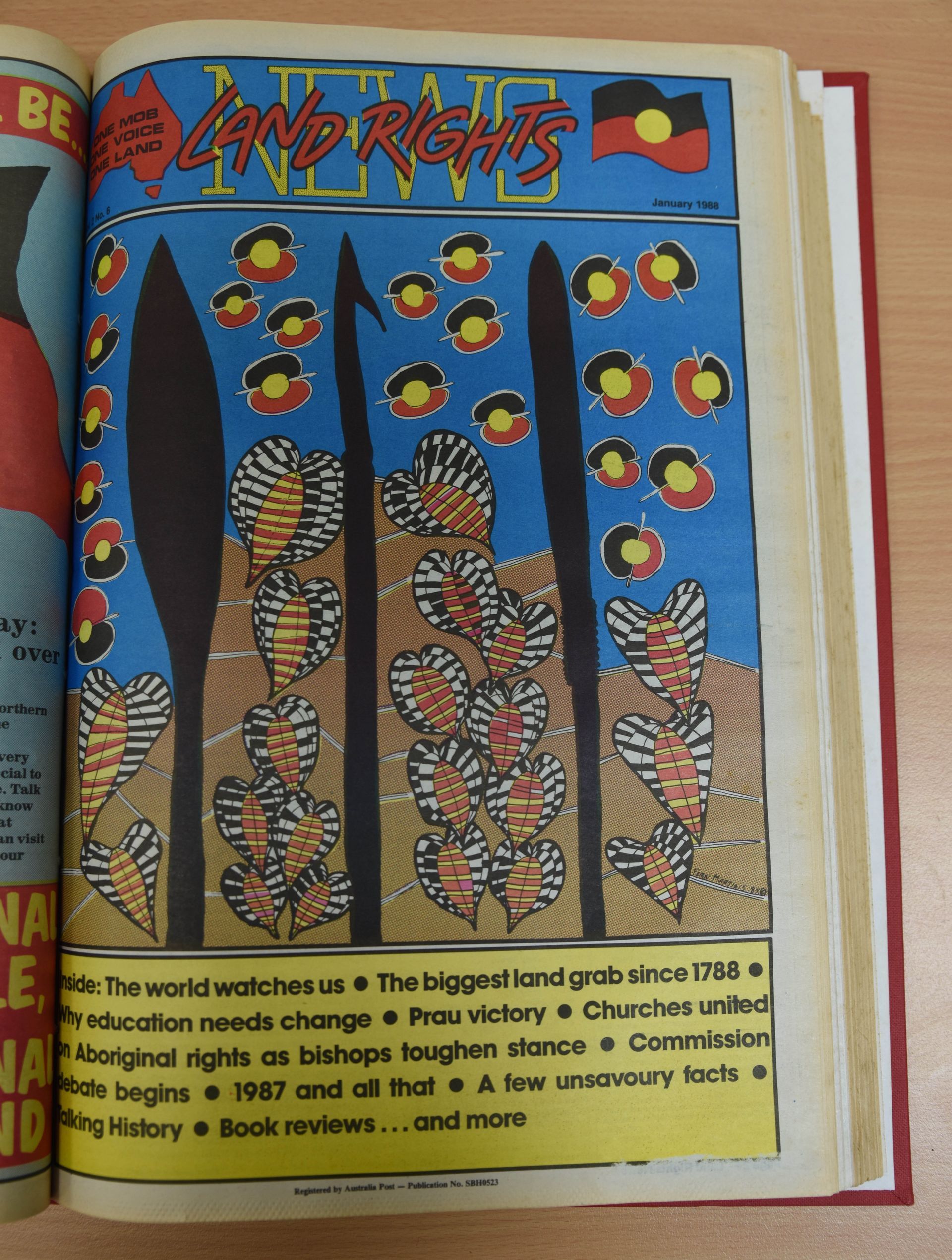Remembering Land Rights News 1988
These days, the Northern and Central Land Councils each publishes its own editions of Land Rights News. Thirty years ago, the time of the Australia’s Bicentenary, Land Rights News was a joint publication, and its production was not without tribulation.

The 1988 cover of Land Rights News.
The artist and writer Chips Mackinolty worked on Land Rights News
for the NLC 30 years ago. In the following contribution, he recalls the difficulties that had to be overcome in the pre-digital age.
The Central and Northern land councils had been planning for the Bicentennial of 1988 for a very long time—indeed the NLC executive had rejected any participation in Bicentennial events as early as 1986. The CLC followed soon after, along with many Aboriginal organisations in the NT.
A key decision made by the two mainland land councils in 1987 was that there be a special anti-Bicentenary edition of Land Rights News , then and for many years afterwards, a co-production.
Running a newspaper from two places—Alice Springs and Darwin—was difficult enough in the days before emails: copy would be faxed, then re-typed, then typeset at the printers. Some poor bugger from the CLC would fly up in the last couple of days to help put the paper to bed.
But for the anti-Bicentenary? The decision was made to produce 100,000 copies, and create and print it in Sydney.
Madness.
Two of us were dispatched to Sydney from Darwin about three weeks out, after already covering stories such as Wally Fejo’s role in the 1 January anti-Bicentenary protest in Darwin on behalf of the Larrakia—and gathering similar yarns from Darwin to La Perouse.
Back in those days, newspaper production was way different. Nothing was digital, and pretty much everything was done by hand: from written copy to type to proofreading; then sending the copy to the printers for typesetting—which would come back in long strips of paper called galleys.Corrections would be made to the galleys and sent back, and then the final strips of type would be cut out and then glued and laid out by hand. Headlines would be made from a plasticised transfer film called Letraset; and “rulings” with Letraline. Scanning didn’t exist then. Physical photographs and graphics—all in black and white—would have to be correctly sized, then sent to a darkroom to be sent back to be laid out as bromides. Colour? Huh! Again spot colour placement would be done as layers, and then carefully laid out “spot colour” separations. Each page could take an hour to produce, with the layouts then sent to the printers to be photographed as a negative film, and then re-made as metal plates.
And only then could the printing start.
Land Rights News was lucky. Redback Grafix—with a long history of supporting Aboriginal organisations in the Territory—hosted the pre-production nightmare at their studio in Annandale, with help from Redback staff including Michael Callaghan and Marie McMahon, as well as others such as the journalist, Kaz Cooke. They all put up with the shouting matches between the two lads from Darwin who had been sent down to put the paper to bed. A kind soul lent us a house around the corner to stay in, as well as store the thousand T-shirts we had brought with us.
We printed at Media Press—then run by Eddie Obeid. They produced most of the student and ethnic newspapers at the time. Eddie got into a bit of trouble a couple of decades later with ICAC, but there you go. There was also a dyslexic typesetter, who sent copy back with different mistakes each time, and the subsequent terror of laying out corrections line-by-line to cover those mistakes. There was what to do with 100,000 40- page newspapers weighing nine tonnes. People lent us trucks, and the Aboriginal and Islander Dance Theatre gave us storage space in an old church in Glebe. More trucks to get the papers to Hyde Park for the 40,000 marchers on the day. More trucks to get them back, and then back on the road interstate after it was all over.
And the edition of Land Rights News itself? It covered a huge range of articles and ideas—including news of the establishment of the Royal Commission into Deaths in Custody, and proposals to establish what would become ATSIC. The cover was by a founding member of Boomalli Aboriginal Artists, Fern Martins. It advertised the Barunga Festival which gave birth to the Barunga Statement, and Bob Hawke’s stillborn promise of a Treaty.
Within weeks we were back in Darwin for the next issue of Land Rights News which, among other things, gave us a wonderful account by John Christophersen—then as now deputy chair of the NLC—about the 1000-strong convoy of Aboriginal people from the Kimberley, the Territory, South Australia and New South Wales who drove by road to Sydney to attend the anti-Bicentenary march.
Later that year, Land Rights News went on the win the media prize in the annual national Human Rights Commission awards. The following year, the biggest and oldest Aboriginal newspaper in Australia started heading towards the digital world, winning Australian Macworld Expo Art Award for tabloid newspapers.
